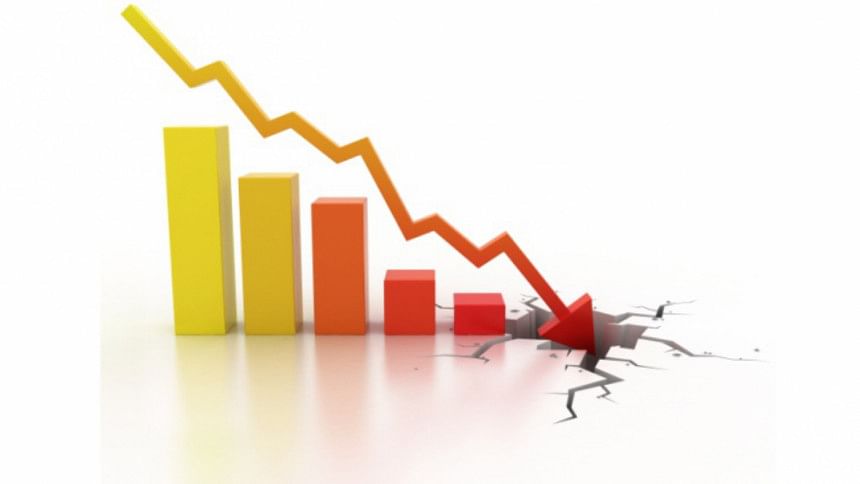The emerging cracks in our external sector

The robust external sector performance has been a strong pillar on which Bangladesh's impressive macroeconomic stability and growth of recent years was founded. The strong performance was underwritten by several factors.
Firstly, the growth and combined earnings of export and remittances contributed to a comfortable current account balance position.
Secondly, the forex reserves had been on a secular rise boosted by inflow of export earnings, remittance flows and inflows of short-, medium- and long-term (MLT) loans.
Thirdly, Bangladesh Bank was able to undertake sterilisation interventions on a regular basis to influence the exchange rate of Taka (BDT) in a way that arrested the slide of BDT at a time when the real effective exchange rate was on the rise.
Fourthly, the debt and debt-servicing liability remained comfortable in the backdrop of the low levels of foreign loans incurred and utilised, and the concessional nature of the loans.
Has there been an exceptional growth in capital productivity to sustain such high growth? There is indeed a clear case to revisit the GDP growth estimates.
The emerging cracks
However, in the last couple of years, cracks have started to appear in the external balance which, if not addressed with the urgency the concern deserves, could not only undermine the external sector performance but also put overall macroeconomic stability and the growth narrative under threat.
Firstly, as evidence bears out, since 2011, for the first time, the overall balance was in the red in FY2018, when it was USD (-) 0.8 billion. This negative position has continued in the first three quarters of FY2019. The negative would have been much higher had the growth of imports not come down significantly, from the high of 25.2 percent in FY2018 to 5.1 percent during July-March of FY2019. If imports post higher growth in FY2020, the deficit in trade and current account will rise further. Much will also depend on commodity price movements.
Secondly, the yawning current account gap is at present being financed through large inflows in the financial account where the overwhelming share is accounted for not by foreign direct investment (FDI) or portfolio investment, but by the inflow of short and MLT loans. This is corroborated by the fast rising loans in the pipeline which increased from USD 18.1 billion in FY2016 to USD 22.1 billion in FY2017 to USD 35.8 billion in FY2018. One will need to keep in mind that since 2015, because of (lower) middle-income graduation, the cost of Bangladesh's borrowings has been on the rise significantly. Thus, accumulated debt and the debt-servicing liability will rise sharply.
Thirdly, with rising import payments, capacity of forex reserves to underwrite imports has been falling sharply, from eight months' equivalent in FY2017 to only about 5.3 months in March FY2019. At the same time, buyers' credit from the private sector has been on the rise, from USD 3.85 billion in December 2015 to USD 10.2 billion in December 2018. In this backdrop, the capacity of the central bank to continue to undertake sterilisation interventions in the foreign exchange market, at least on the scale seen in recent past years, may be rather limited.
The cumulative impact of the external sector trends is clearly depicted by the distance between the 7FYP targets and the actual on-the-ground performance. The overall balance in 7FYP was envisaged to be a positive of USD 5.45 billion in FY2019 instead of the negative estimated for this year based on trends so far (for July-March FY2019, the overall balance stood at (-) USD 0.33 billion). Net FDI was projected to be USD 7.4 billion for FY2019 (and about USD 10 billion in FY2020) as against actual figures averaging around less than USD 2 billion annually.
Addressing the emerging tensions
It will not be easy for Bangladesh's policymakers to deal with these cracks. A lot will depend on Bangladesh's capacity to enhance forex earnings from exports and remittances. In a welcome development, export growth rate in FY2019, at about 11.6 percent in FY2019 (July-April), surpassed the target of 6.4 percent. Remittances have also posted an impressive growth of 10 percent over the corresponding period, although the number of workers going abroad in this period has come down by more than 11 percent. This will likely have a lagged response and slow down future growth.
From a medium-term perspective, the urgency of a push towards export diversification, move up the value chain to more value-added products and skills upgradation towards higher competitiveness cannot be overemphasised. However, in the short-term, the expected deficit in the current account may be brought down by containing imports. As was noted earlier, import growth has come down sharply in FY2019. Fiscal measures are an option. The import tariffs on rice have been raised significantly in recent times to discourage imports. The government may also consider raising import duties on selected luxury items and consumer goods. The other option to discourage imports is to go for raising LC margins for imports. Indeed, the Bangladesh Bank has already been resorting to this measure selectively.
As was pointed out, capacity to deploy sterilisation interventions by the Bangladesh Bank has weakened in the face of depleting reserves. Bangladesh's export competitors have gone for significant depreciation of respective currencies over the recent years. Since sharp depreciation will have adverse implications for import payments, inflation and consumer prices and interest payments, a gradual depreciation of the BDT would be the preferred option. Indeed, this has been the strategy pursued by the central bank which needs to be continued. However, debt-servicing liabilities will keep on rising in view of the rising aid flows noted earlier. The apprehension is that if the pressure on the reserves keeps on rising, undertaking sterilisation may become increasingly difficult. Realising the aspirations of 7FYP—to bring in more FDI in the range of USD 7-9 billion annually—must be given top priority to enhance exports and improve the overall balance situation.
There is no easy solution in dealing with the emerging cracks that are weakening Bangladesh's external sector position and performance. How the 7FYP GDP growth targets are being achieved—and even being exceeded—in spite of the disquieting external sector scenario remains a disturbing question though. In recent times, many experts have questioned the GDP growth rate figures on the ground that they do not correspond with key variables contributing to macroeconomic and sectoral performance of the Bangladesh economy, more particularly the investment figures.
As the above discussion bears out, as far as the external sector is concerned, key variables have significantly underperformed in FY2019 against what was projected for FY2019 in the 7FYP (for example, USD 7 billion of net FDI projected in the 7FYP compared to less than the USD 2 billion projected for this year; export projection of USD 47.5 billion in the 7FYP instead of the estimated USD 42.5 billion for this year; positive overall balance projected in 7FYP instead of the negative balance of this year). The projected net FDI flow during the first four years according to the 7FYP was to the tune of USD 20.2 billion against the realised amount of about USD 7 billion actually received over the corresponding period. At the same time, the GDP growth figure for FY2019 has been estimated to be 8.13 percent, which is higher than the figure of 7.6 percent projected for FY2019 in the 7FYP.
Has there been an exceptional growth in capital productivity to sustain such high growth? There is indeed a clear case to revisit the GDP growth estimates.
Policymakers should be concerned about the external sector challenges which come at a time when Bangladesh needs to take adequate preparations to face the implications of the country's dual graduation, with the anticipated rising competitive pressure on export performance because of preference erosion (emanating from the LDC graduation), and the escalating cost and more stringent conditionalities associated with foreign borrowing (originating from the middle-income graduation).
Against this backdrop, concrete initiatives to raise export competitiveness, ensure appropriate use of foreign funds and improve the quality of external sector management cannot be overemphasised.
Dr Mustafizur Rahman is a Distinguished Fellow at the Centre for Policy Dialogue (CPD), Dhaka.
Follow The Daily Star Opinion on Facebook for the latest opinions, commentaries and analyses by experts and professionals.
To contribute your article or letter to The Daily Star Opinion, see our guidelines for submission.

 For all latest news, follow The Daily Star's Google News channel.
For all latest news, follow The Daily Star's Google News channel. 



Comments